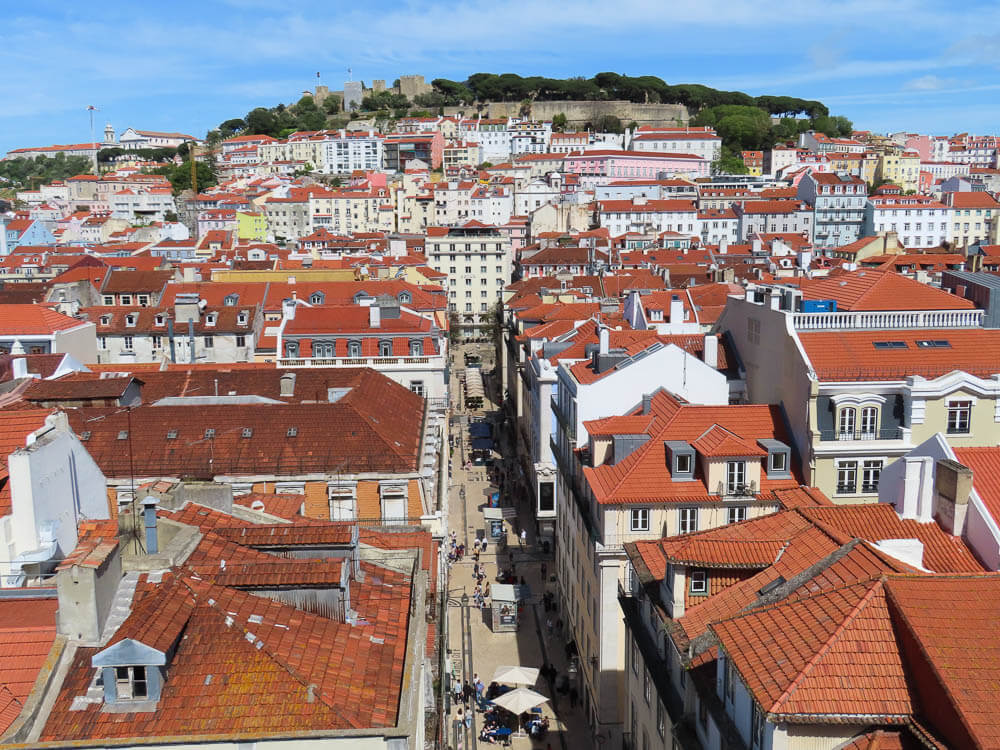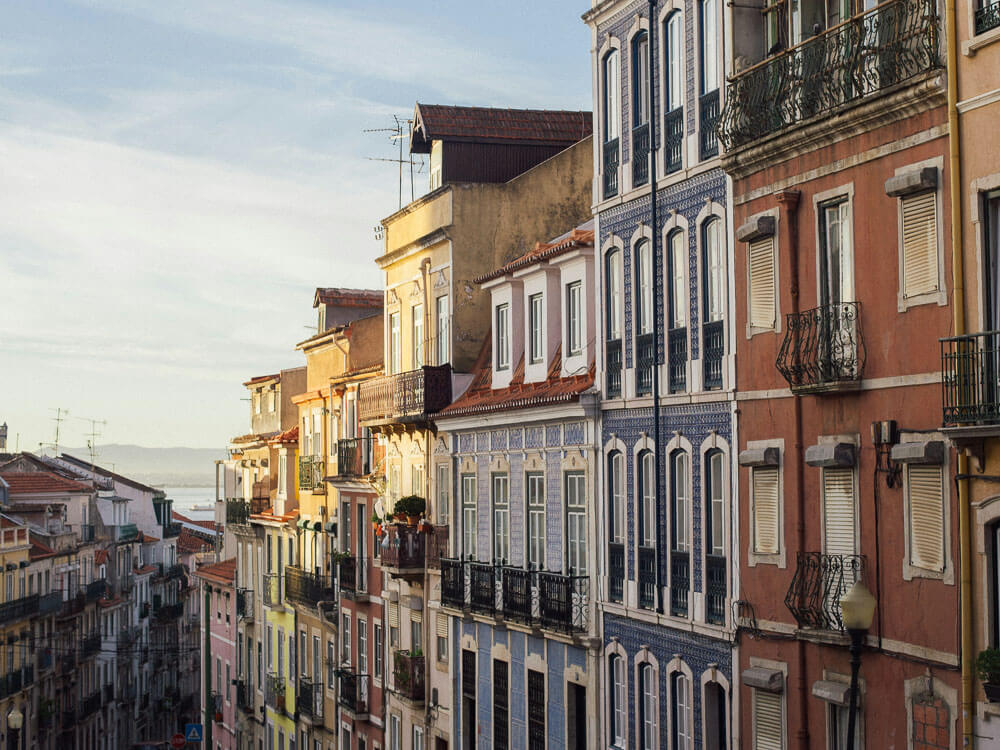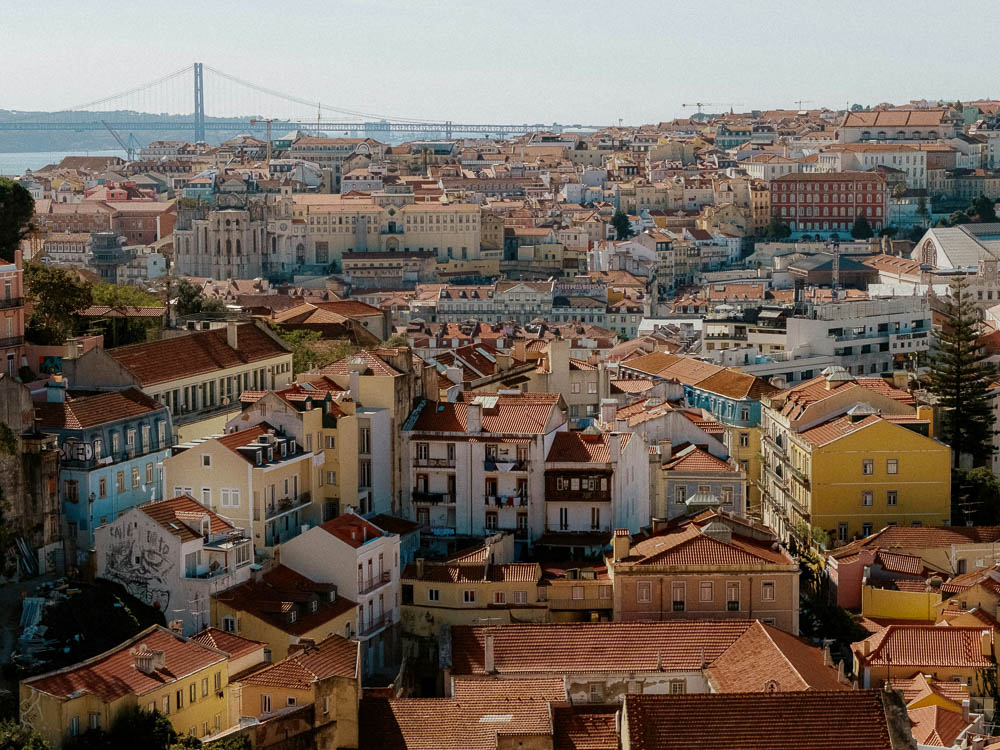What can you see in 48 hours in Lisbon? Well, with the right itinerary, there’s a lot you can do! This post will give you a complete schedule so you can make the most of your time in Portugal’s capital.
If you’re planning to spend 48 hours in Lisbon, but still aren’t sure what you should do during your time there, then you definitely need this guide!
As someone who’s been living here for quite some time now, I’ve got all the information you need to be able to enjoy every second of your time in Lisbon.
This itinerary covers the main tourist attractions and the activities you should do to immerse yourself in Portuguese culture and get a sense of local life. So, without further ado, come and find out how to experience the best 48 hours in Lisbon!
Index
- Day 1: Alfama and Baixa-Chiado
- Day 2: Belém and museums
- Is 48h in Lisbon enough?
- Have some extra time?
- Tips for maximizing your 48 hours in Lisbon
- How to get around Lisbon?
- Where to stay?

1. Day 1: Alfama and Baixa-Chiado
To enjoy your 48 hours in Lisbon to the maximum, you have to be prepared to have an early morning and late night, with lots of walking in between.
On your first day, you’ll visit Alfama, the oldest neighborhood in the city, and Baixa-Chiado, both places where you’ll find some of the most famous tourist attractions in Lisbon. So, get your walking shoes ready and let’s dive right in!
1.1. Morning Schedule

Start your first day by going to one of the highest point of the Alfama neighborhood, Castelo de São Jorge. This ancient fortress was built by the Moors, dating back to the 12th century, and offers incredible views over Lisbon.
From there, head down to Miradouro de Santa Luzia and Miradouro das Portas do Sol. These viewpoints are located right next to each other, and allow you to see across the red rooftops of Alfama, all the way down to the Tagus River.
Then, continue your journey through the cultural highlights of Alfama by going to the ruins of the Roman Amphitheater, an incredible piece of Lisbon’s history, dating back to the Roman occupation of the city.
After that, make your way down to the Aljube Museum of Resistance to gain insight into Portugal’s fight for freedom against Salazar’s dictatorship. Right in front of the museum, you’ll find the famous Lisbon Cathedral (Sé de Lisboa) and, next to it, St. Anthony’s Church, both of which are worth visiting.
A short walk away from these attractions is Casa dos Bicos, which you’ve probably seen in pictures before. That’s where the José Saramago Foundation is located, honoring the Nobel-winning Portuguese author. If you don’t want to go inside, at least take a few moments to appreciate its unique façade!
By then, it should be time for lunch. There are many amazing restaurants that serve traditional Portuguese cuisine in Alfama, so explore your surroundings to find one that appeals to you.
After a good meal, you’ll be ready for an afternoon exploring more of Lisbon!
1.2. Afternoon schedule

After lunch in Alfama, I suggest spending the afternoon visiting central Lisbon. Your first stop will be at Commerce Square (Praça do Comércio), a large riverside square that marks the entrance to Baixa.
At the square, you’ll find the famous Rua Augusta Arch, a monument built to celebrate the city’s reconstruction after the 1755 earthquake. You can either appreciate it from the ground or go to the top for some more amazing views of the river.
A short walk from there, you’ll find the Santa Justa Lift (Elevador de Santa Justa), an early 20th-century iron wrought lift that resembles the Eiffel Tower and offers views over Lisbon’s streets.
Close by is Rossio Square, or Praça Dom Pedro IV, which serves as a meeting place for both locals and tourists, with its cafes and fountains. It’s a great spot for observing a bit of the city life during your limited time in Lisbon!
Next, head to Church of Saint Roch and take some time to appreciate its Baroque interiors, and then visit the ruins of Carmo Convent, a former medieval convent that was destroyed by the earthquake and remains an important part of the city’s history.
Following that, go to Livraria Bertrand in Chiado. This is the world’s oldest bookstore still in operation, an absolute must-visit for any book lover! Then, end your afternoon with a stroll through Chiado.
There, I recommend exploring the stores, cafes and various cultural venues while you soak up the atmosphere. Chiado is one of those places that perfectly encapsulates Lisbon’s essence, with its mix of modern and historical elements. Truly the best way to end your afternoon!
1.3. Evening schedule

As evening falls, head to the city’s nightlife hotspot: Bairro Alto. This neighborhood is popular not only among tourists, but also locals who are looking to engage with the city’s social scene. It’s one of the best ways to experience local life, especially when on a tight schedule of 48 hours in Lisbon!
Bairro Alto offers various restaurants that serve both Portuguese dishes and international cuisine, ensuring that everyone can enjoy some great food after a day of sightseeing.
Besides that, this area is also known for the numerous fado houses found throughout its streets. Fado is a traditional Portuguese music genre, marked by deep emotional singing accompanied by guitars.
There’s no better way to finish your first day of exploring Lisbon than having dinner at one of these fado houses. That way, you’ll get to try some great food while enjoying a magical performance that is deeply rooted in Portugal’s traditions.
2. Day 2: Belém and museums
2.1. Morning schedule

Day two of your 48 hours in Lisbon will begin with a visit to the Belém district, located just 15 minutes from the city center. Getting there is quite easy, as you can use public transport or take a taxi/Uber, and I recommend arriving early to avoid crowds at the attractions.
Your starting point there will be Jerónimos Monastery (Mosteiro dos Jerónimos), which is one of my favorite places in the city. This UNESCO World Heritage monument started being built in 1501 and was only completed a century later. It’s the best example of Manueline architecture, characterized by its ornate decorations and maritime themes.
From there, head to Santa Maria de Belém Church and then you have to try Lisbon’s famous custard tarts at Pastéis de Belém, home to the original recipe of pastéis de nata.
After getting your fill of what may very well be the best dessert in the world, take a walk through the Tropical Botanical Garden, where you’ll find a great variety of plants from Portugal’s old colonies. Then, visit Palácio Nacional de Belém, a former royal property that is now the President’s residence.
To finish your morning schedule, have lunch at one of Belém’s restaurants before going back for some more exploring in the city.
2.2. Afternoon Schedule

After your deserved lunch break, continue your 48 hours in Lisbon by visiting a few of the city’s renowned museums.
Start at the National Coach Museum, which displays a collection of historical carriages that provide insight into Europe’s transportation history. If you’re interested in contemporary art, you should also visit MAAT (Museum of Art, Architecture and Technology), a unique building by the river where you’ll find modern exhibitions.
After visiting these museums, go for a walk along the Tagus River until you reach the Monument of Discoveries (Padrão dos Descobrimentos). This landmark honors Portugal’s exploratory history and features an observation deck with wide views of the river.
Nearby is Centro Cultural de Belém (CCB), which regularly offers various cultural events and exhibits. Then, as evening approaches, head to Belém Tower and embark on a sunset cruise on the Tagus River. That way, you’ll have amazing views of Lisbon’s landmarks as they’re illuminated by the setting sun.
Last but not least, finish your 48 hours in Lisbon with dinner at LX Factory, an industrial space that was transformed into a dining area where you can try various Portuguese dishes in a unique setting. The perfect way to end your time in the city!
3. Is 48 hours in Lisbon enough?

As you can see by the itinerary above, it’s possible to see and do a lot of things in 48 hours in Lisbon. Of course, there are many more things to do in the city. You could stay a whole week and still not run out of things to do!
However, two days is enough to see the main attractions and get a taste of Portuguese culture and daily life. Just be prepared for full days that start early in the morning and continue way into the evening.
Another thing you should keep in mind is that this itinerary is merely a suggestion, and you can add or remove stops as you please. To optimize your time, decide what attractions you want to see the most and plan accordingly.
And, if you really love what you see during your 48 hours in Lisbon, you can always come back later with more time to explore everything the city has to offer. Trust me, chances are you’ll fall in love with Lisbon and wish to visit it again and again!
3. Have some extra time?
If you happen to have some extra time on your hands after your initial 48 hours in Lisbon, I’d recommend exploring nearby towns and cities. Here are some of the best options:
- Sintra: a UNESCO World Heritage site with lots of historical buildings, such as the magical Pena Palace and the Moorish Castle.
- Cascais: a former fishing village that is easily accessible from Lisbon, it has beautiful beaches, a historical town center, and the incredible Boca do Inferno cliffs.
- Óbidos: a well-preserved medieval town that offers visitors the chance to experience this ancient architecture, including castle walls and a historic town center. It’s also the birthplace of the ginjinha liqueur.
- Évora: a town where you’ll find several ancient sites like the Roman Temple of Évora and Chapel of Bones, which is built completely out of bones. Whether that’s spooky or very cool, it’s up to you!
- Nazaré: a must-visit to surf enthusiasts. This coastal town is recognized for its giant waves that can reach up to 86 feet!
5. Tips for maximizing your 48 hours in Lisbon
To make the most of your 48-hour trip to Lisbon, planning is the most important thing. Start by deciding which attractions and views you want to see, as they will guide your itinerary. Still, you should be flexible and be open to spontaneous stops or possible changes due to weather conditions.
Besides that, begin your days early and stay out later. Take advantage of the fact that mornings tend to offer quieter moments at busy sites like Jerónimos Monastery. In the evening, enjoy the dinner options and nightlife that neighborhoods such as Bairro Alto provide.
Joining guided tours or using hop-on-hop-off buses is also a good idea, as they help you navigate the city with ease and are particularly useful when time is short.
Another thing to remember is that staying in central locations can help you save a lot of time when it comes to reaching the main attractions. That way, you’ll be closer to public transport options or within walking distance of many attractions.
6. How to get around Lisbon?
Although Portugal’s capital may be a walkable city, navigating its many hills can be time-consuming. So, when you have just 48 hours in Lisbon, I’d advise that you use the city’s well-connected public transportation.
For example, the tram system (including the well-known Tram 28) offers a convenient and quick way to move around, as does the metro. Both are suitable for covering longer distances, and run regularly so you don’t have to worry about wasting time.
Meanwhile, funiculars, such as Elevador de Santa Justa, are very useful for steep areas or when you want to save energy while still enjoying views of the city. Buses reach wider areas of Lisbon not served by trams or metros and run until late at night, which is great for maximizing your travel time during your brief stay.
7. Where to stay?
There’s no shortage of great places to stay in central Lisbon, but narrowing down the options can be a bit overwhelming. So, to help you find the perfect place, I’ll share my main recommendations in the area! Here they are:
- Esqina Cosmopolitan Lodge: near the active Rossio area, this 4-star hotel provides air-conditioned rooms and free Wi-Fi. Guests have access to amenities such as a terrace and on-site dining with a bar and restaurant. Its central location makes it ideal for those who want to explore Lisbon thoroughly in their 48-hour stay.
- Lisboa Carmo Hotel: located three minutes from Bairro Alto, this hotel offers rooms that combine traditional elements with modern design and views of the river and old town. It features air conditioning and minibar facilities in each room, along with breakfast service and its own restaurant and bar.
- Cais Urban Lodge: situated near Commerce Square, this hotel is ideal for visitors who are short on time but want convenient access to the main sights. The lodge includes air-conditioned rooms with free WiFi, and some of them include balconies with views over the city.
So, ready for your 48 hours in Lisbon?

A 48-hour stay in Lisbon may not seem like a lot, but within this timeframe it’s totally possible to see the main attractions, get a taste of the Portuguese lifestyle and understand what makes this city so unique and special.
By following this itinerary, you’ll be able to visit Alfama’s charming cobblestone streets, enjoy a fado performance, eat great food, visit plenty of museums and see the main sights of Lisbon.
Hopefully, you’ll fall in love with Portugal’s capital just as I did, and end up visiting it again to explore its history and culture more fully!







